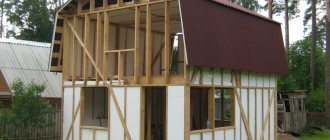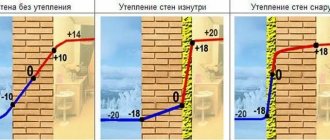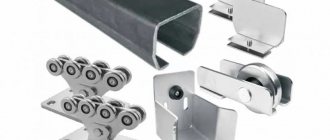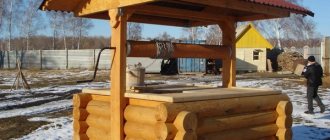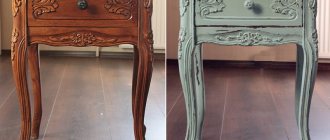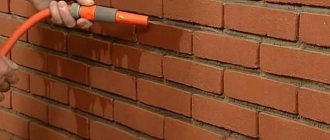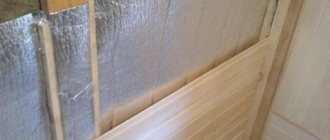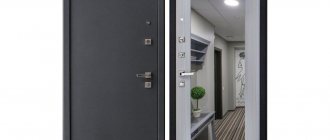Concrete is the main building material. It is found everywhere and has many positive characteristics. But its thermal conductivity coefficient is high, so the material is cold. Heat escapes through the walls, so a lot of money is spent on heating. The only option is to insulate concrete walls. There are many materials for this purpose, and the work itself can be done with your own hands.
Thermal insulation of concrete - features
The peculiarity of concrete walls is that in order to insulate them, everything needs to be calculated and planned in advance. The task is not easy when compared with walls made of brick or wood, but it is doable. Insulation of a concrete wall outside and inside has the following features:
- The surface must be treated with antiseptic agents.
- Communications and wiring are laid even before thermal insulation work.
- When insulating a façade, the entire area is treated; you cannot do only certain areas or a wall.
- Areas behind heating radiators are treated using insulation with foil. This is a thin aluminum layer on insulation. It will reflect thermal energy.
If we talk about internal insulation, there are also some nuances here. For example, condensation will accumulate inside, since the moisture has nowhere to go. Therefore, it is important to ensure good ventilation. In addition, environmentally friendly insulation is selected that will not harm health.
Application of ceramic-isol
In the modern market, new promising technologies are replacing traditional building materials; production produces universal products that have increased efficiency when used. Keramo-izol is an environmentally friendly composition and does not pose any danger to human health, which is an important aspect in its application. Installation does not require complex preparatory processes, application is simple with a long service life. Liquid thermal insulation suspension successfully protects against cold, creating coziness and comfort in the rooms.
Keramo-izol is used for everything that can be painted. Application is carried out with a brush, spray gun, or foam roller. The suspension has good adhesion and is easily applied to the surfaces of monolithic structures. The environmentally friendly product has advantages that are appreciated in the construction industry.
Pros:
• good thermal insulation properties - reduction of heat loss by 1/3;
• easy to use, application can be done independently;
• can be applied to structures of different shapes;
• the range of shades for painting is varied;
• resistance to ultraviolet radiation;
• has anti-corrosion properties.
Keramo-izol is a universal means for creating an atmosphere of warmth in your home.
Where to insulate, inside or outside
The first question that arises before starting insulation. The answer to this is ambiguous, since these options have their pros and cons. For example, insulation from the inside is often done in apartments with more than 3 floors, especially in high-rise buildings, since working outside is dangerous. In addition, the heat insulator inside will not be exposed to the negative influence of the street, and the insulation process itself can be performed in any weather and season. But there are also disadvantages: reduction in living space, condensation formation, release of harmful substances.
External insulation is a more common option, as it allows you to protect a concrete wall and cover it. It is more convenient to work outside and there is no loss of living space. There is no human contact. And the insulation inside causes the wall to freeze itself. A phenomenon occurs in which the wall, on one side, is insulated from the heat of the rooms, and on the other side is constantly exposed to sub-zero temperatures. That is why it is better to insulate concrete walls from the outside. But it is still up to the owner to choose methods for insulating concrete structures.
Thermal insulation plaster
The secret of heat-insulating plaster lies in polystyrene foam bubbles with air, they create thermal insulation. Plaster must be applied to a prepared base; this is the simplest and most common method of fastening. The product is expensive and in demand; it is best to purchase plaster in specialized stores; purchasing it on the market risks purchasing a fake. You should check the documentation and certificate of conformity to be sure of the effectiveness of the composition when used.
Technologies for carrying out insulation work come in two options: external and internal methods. The main technological procedures are:
- Wet method - gluing sheets to a pre-prepared base with special glue, followed by plastering. Plus - the simplicity of the installation process itself.
- The dry method (frame) is more complex; hiring professionals is the most advisable solution.
External treatment of the facade is much more effective, but for a number of reasons, internal thermal insulation is often carried out. In any case, comfort and coziness in the living space is ensured.
Insulation methods
A variety of insulation methods allows you to choose the best option for yourself, in accordance with your financial capabilities and preferences.
The first option is to use polystyrene foam
Polystyrene foam is a cheap and practical material. Suitable for those who have a limited budget, at the same time, it has excellent characteristics. You can buy EPS (extruded polystyrene foam). It has better characteristics, but the price is not very high. But it is not recommended to insulate concrete walls from the inside.
Algorithm for performing the work:
- Along the perimeter at the bottom there is a plinth that will serve as a stand for sheets.
- Fixation is done with glue. Can be applied in a continuous layer with a notched trowel or in spots, around the perimeter and in the center.
- The first mat is fixed from the corner, and so on for the entire row. The rest are close to them. The next row is laid offset so that the seams of adjacent rows do not intersect.
- Additionally, the mats are fixed using dowels with an umbrella. Holes are drilled using a hammer drill and dowels are driven in. For 1 sheet you need 5 dowels.
- When the glue dries (from 1 to 2 days), the reinforcing mesh is glued. To do this, glue is applied to the foam, and the mesh is embedded in it. An overlap of 5-10 cm is made at the joints.
- After drying, the walls are plastered.
At the end, all that remains is to prime the wall and do the finishing touches. This method is called a wet facade.
The second option is to use PPU
Polyurethane foam is a heat insulator applied by spraying. It is somewhat reminiscent of polyurethane foam. When the components are mixed and react with air, the material begins to increase in size, filling the entire space. The option is modern and effective. The material is not afraid of moisture. Internal and external insulation is possible. However, the process of insulating concrete walls with polyurethane foam requires special, expensive equipment.
The work is done quickly, the layer turns out monolithic, without cold bridges. However, it is vulnerable to UV rays. In addition, the layer does not allow steam to pass through; a ventilation system is needed. The essence of the work is to apply material from the compressor to the surface.
The third option is thermal insulation plaster
If you need a cheap, quick way to insulate concrete walls, then you can use heat-insulating plaster. However, it is not a full-fledged heat insulator; for cold regions this is not an option, only combination with other materials.
Cost of work
Table with approximate prices:
| Thermal insulation grade | Size | Material price, rub. | Cost of work, rub. Moscow | Cost of work, rub. Yaroslavl | Cost of work, rub. Voronezh |
| Akterm Concrete | 20 l | 7000 | 350 m2 | 200 m2 | 230 m2 |
| Polyurethane foam spraying method | Packaging, 4 m3 | 5300 | 900 m3 | 790 m3 | 800 m3 |
| Basalt mineral wool GREENGUARG | 0.288 m3 | 510 | 300 m2 | 250 m2 | 270 m2 |
| Insulation: Expanded polystyrene boards. extrusion TECHNONICOL | 0.273 m3 | 1356 | 500 m2 | 350 m2 | 300 m2 |
| Penoplex Facade, glue, doweling | 1185 mm x 585 mm x 50 mm, pack of 4 pieces | 1370 | 600 m2 | 450 m2 | 430 m2 |
Insulation instructions
If you do not take into account the option of using polyurethane foam, then all the work is done with your own hands. It is important to familiarize yourself with some nuances and begin the task:
- Insulation of concrete walls is carried out in dry weather, at temperatures from +5 to +30 degrees.
- The wall is well dried, not damp.
- It is important to clean the surface, remove all excess, seal cracks and level it. Mold, mildew, and greasy stains are removed.
At the end, all that remains is to treat the concrete with an antiseptic and get to work.
Using polystyrene foam
The advantages of polystyrene foam are considered, as is the technology for creating a wet facade. But, there is a second option - frame. Sequence of work:
- The sheathing is placed on the surface.
- The distance between the slats is identical to the width of the foam sheet.
- Insulation is installed in the created cells.
- Everything is covered with lathing and the structure is finished with finishing panels: block house, lining, siding.
For insulation in cold regions, the layer thickness is from 10 to 20 cm.
Using mineral wool
Mineral wool is an excellent material with excellent characteristics. However, she is afraid of moisture. Therefore, when thermally insulating concrete, it is necessary to create a ventilation gap so that the wool dries. Here we need the frame technology described above.
Features of the work: after creating the sheathing, mats or rolls of mineral wool are installed. It is important to lay them tightly, without forming joints. To do this, the distance between the slats is made 5–10 mm less than the width of the wool. All that remains is to fix the vapor barrier, glue the joints and sheathe the frame with the selected material. An apartment can be insulated with mineral wool both from the outside and from the inside.
Using thermal panels
Thermal panels are a multilayer material. It is made of insulation and decorative material. The manufacturer has simplified the task; a concrete house can be insulated with such panels, and not have to think about additional finishing. Typically used for exterior decoration. Installation is simple - just apply glue to the surface and fix it on the wall.
Using foam glass and fiberglass
Foam glass is an insulating material in the form of slabs, the density of which is from 100 to 150 kk/m3. Such insulation is fixed to the wall using glue. The structure can be strengthened with dowels, as is the case with polystyrene foam. The finishing layer is different, ordinary plaster, drywall or decorative panels.
The peculiarity of the material is that it is not afraid of moisture, is environmentally friendly, and is not damaged by rodents. Cutting mats is quite simple. The surface can be strengthened and secured with reinforcing mesh and corners. The disadvantage of such insulation for concrete is that it has a high cost.
Using penofol
This is foil insulation. It is environmentally friendly, efficient and practical. The thickness is small, which allows you to quickly fix it on the wall. The layer is vapor-proof. However, penofol is not suitable as the only insulation material. It is better to combine it with other heat insulators or use it as a heat-reflecting layer and vapor barrier material. Installation is carried out on the wall or on the lathing.
Before insulating concrete walls, it is important to think through the sequence of work in advance, choose what to insulate the structure with, comparing all the pros and cons, and then get to work. But, if you are unsure of your abilities, it is better to overpay, but entrust the work to specialists who will do it efficiently and without errors.
How to properly insulate walls with expanded polystyrene and extruded polystyrene foam (EPS) from the outside
I described in detail about insulating walls with polystyrene foam in one of the previous articles. Here I will mention some main points.
Preparing the wall for installation of insulation
The first thing you need to do before insulating the walls with polystyrene foam or EPS is to clean the outside walls of the house from dirt, dust and, last but not least, level them. After this, they must be primed if you use glue to install the insulation.
If there are significant holes in the wall that you cannot level with glue, then after installing the insulation, a void may remain between the polystyrene foam board and the wall. And this is extremely undesirable, because even a light blow or push on the insulation in the place where the hole is can deform it or break it. If during the insulation process you encounter a small bump, it will be difficult for you to glue the polystyrene foam sheet in that place tightly to the wall.
Installation of polystyrene foam and EPS on the wall
Expanded polystyrene, as a rule, is glued to the wall using a special adhesive for polystyrene foam boards, and sometimes with special “fungi”.
In the case of insulation of extruded polystyrene foam (EPS), it is necessary to make the surface on which the glue will be applied rough. There are no such problems with polystyrene foam; the glue glues it well without additional processing, while EPS has a smoother surface, so it needs to be processed.
Very often, for reinforcement, polystyrene foam is attached simultaneously with glue and “fungi”, which is the most reliable and correct solution.
After installing the insulation, as a rule, the outside walls are plastered or lined with facing bricks.
Insulation with polystyrene foam using wooden slats
There is another type of installation of polystyrene foam boards - using a frame made of slats or other suitable material.
Slats are mounted to the wall, the thickness of which should not be less than the thickness of the insulation, or even better, it should be larger to create a ventilated space between the polystyrene foam and the cladding. The distance between the slats is chosen so that the polystyrene foam boards are tightly inserted between them without falling out.
This type of installation is acceptable if you do not plaster or line the walls with brick, but cover them with siding, for example. In this case, the slats will also become the basis for attaching facing materials.
How to properly insulate external walls with mineral wool
Another popular insulation for house walls is mineral wool insulation.
Insulating walls with mineral wool differs from insulating walls with polystyrene foam boards, primarily due to the characteristics of the insulation materials themselves.
Mineral wool, unlike expanded polystyrene, is not a sufficiently rigid insulation material, so installation of mineral wool is usually carried out using the frame method. But if the cotton insulation is of sufficient density, then builders also do not hesitate to install it with glue.
A frame is constructed from slats or small bars, and mineral wool is laid or rolled between them.
If the wall is concrete or brick, the bars are attached to the wall using dowel nails. Well, if the wall of the house is wooden, then use self-tapping screws. Additionally, you can secure the mineral wool with “fungi” so that it does not roll down.
Since cotton insulation absorbs moisture very well, it will be necessary to provide waterproofing on top of the insulation. Without this, mineral wool will absorb moisture from the street and you can forget about the insulation effect.
It is also advisable to build more or less reliable protection against various rodents by installing metal strips along the edges of the wall.
When facing walls from the outside with brick, insulation is placed between the main wall and the facing wall, and these two walls are connected with special bonds that pierce the mineral wool and at the same time hold it inside the wall, preventing it from rolling down in the future.
Common mistakes when insulating concrete walls
Most mistakes come down to the wrong method of insulation. Namely, insulation from the inside. This is fraught with many negative consequences. In addition, it is better to choose moisture-proof materials as insulation.
Sometimes insufficient attention is paid to the preparation of a concrete wall: cracks are not repaired, mold, stains or mildew are not eliminated. This can lead to the insulation cake peeling off and all the work will be in vain.
When creating a reinforced layer on a wet facade, it is important to place the mesh correctly. It will strengthen the structure and protect the surface from cracks. However, it cannot be glued to foam plastic and glue should be applied on top. In order for the mesh to perform its functions, it is embedded in a layer of glue. Then the mesh will be inside the adhesive mass.
Another mistake is failure to maintain temperature conditions when working outside. The insulation process is carried out in dry weather, at the specified temperatures. If it is below +5 degrees outside, it is better to wait for comfortable conditions.
If you follow all the recommendations, you can avoid mistakes and the work done will not be in vain.
Mineral wool
The insulation is available in the form of rolls or in a modern version in the form of slabs. The benefits consist of many factors that deserve the consumer's attention.
- thermal conductivity is low;
- the product is environmentally friendly;
- Rodents do not like mineral wool;
- fire-fighting properties - not susceptible to persecution;
- long service life.
- moisture resistance at a low level;
- installation requires preparation in choosing a waterproofing coating;
- When compressed, it loses its thermal insulation properties.
Due to the price/quality ratio, mineral wool is in consumer demand.
Pipeline insulation
Sewerage and water supply are those systems that are connected outside the house. In some cases, they are not provided with thermal insulation at the required level, which is why the water in the riser freezes or the drain becomes clogged. To insulate communications, foil insulators, polystyrene foam, penoizol, polyurethane foam or basalt sleeves are used. To carry out the procedure, you need to dig out the place where the pipes are inserted into the house. The further process is performed according to the following algorithm:
- the pipe is cleaned of plaque and dirt;
- heat-insulating material is applied;
- cover the joints with the wall with polyurethane foam;
- wrap the heat insulator with polyethylene.
If you were excavating a pipe, you need to fill the hole with expanded clay and compact it with soil on top. After completing all procedures for thermal insulation of a private residential building, the temperature in the room during cold times will increase noticeably and will remain for a longer period after heating. If it is not possible to isolate the house from the outside, the entire procedure can be carried out from the inside, but this option will take up some space from the room.
Causes of moisture
The first thing you need to figure out is why moisture began to appear on the walls of your home. There may be several reasons for this phenomenon and each of them requires its own solution. Most often, the walls begin to sweat in the following cases:
- There is poor or no ventilation in the room.
- The structures are freezing.
- The waterproofing is broken.
- The room was recently renovated.
The only scenario in which you should not worry and take radical measures would be the case of repairs. When performing various finishing works, mixtures are used that contain water and it actively evaporates. After a certain time this passes and everything becomes normal. If the water appeared for another reason, you will need to urgently take some action.
Even if the reason for the appearance of water is a recent renovation, it is better not to aggravate the situation and ventilate more often. Of course, you should take into account the recommendations of manufacturers of finishing materials and in some cases it is better to avoid ventilation. Then you should ensure the best possible air distribution throughout the entire area of the house - open all doors wide.
Tips and tricks from experts
One of the key difficulties of insulating a room from the inside is that the insulated wall does not become warmer, on the contrary, it begins to cool even more. In this state of affairs, the dew point shifts closer to the inner section of the wall. Condensation appears, leading to an increase in humidity, and the wall itself and the finishing layers suffer from this. The insulating characteristics of the insulation are significantly reduced. In fact, the level of heat loss remains the same, but increased humidity is formed. Brick surfaces suffer especially greatly from such exposure.
Fortunately, this problem is solvable. One has only to choose a heat insulator with a reduced level of moisture absorption and vapor permeability. The structure of such insulation should not contain fibers. During installation, avoid the formation of joints or gaps that will allow condensation to enter the room and air to penetrate into the interlayer space.
The following types of insulating materials do not meet the above criteria:
- warm plaster;
- cork covering;
- liquid ceramics;
- drywall;
- mineral wool.
GKL and plaster can only be used at the final stage of thermal insulation of the room.
This type of material such as penoplex or expanded polystyrene also does not cause delight among experienced builders. This is due to the fact that this slab material is difficult to perfectly join. If you do not use special adhesive solutions, it will not attach well to the wall. As a result, the level of tightness decreases, which leads to the difficulties described above.
What materials and tools need to be purchased?
Tools for installing thermal insulation.
- Thermal insulation in the form of sheets, slabs or liquid.
- Deep penetration primer composition.
- Antiseptic.
- Sealant or mastic.
- Special plaster mixture for bathrooms or swimming pools.
- Metal construction mesh.
- Wooden slats.
- Brick or plasterboard sheets.
- Waterproofing materials.
- Vapor-proof film.
- Metal profile for installing drywall.
- Drill with mixer attachment.
- Needle roller.
- Rule.
- Plastic beacons.
- Spatula-comb.
- Building level.
- Screws, dowels, plates for suspension.
To insulate concrete walls, you can use different materials and methods of installation. It all depends on the financial capabilities of the apartment owner. Desire alone is not enough in this matter. It is best to insulate walls in summer, when it is hot. Then you won’t need to dry them using heaters. When work is completed, the owner of the premises must be prepared for the fact that the area of his apartment will decrease somewhat, but in winter the desired temperature will be maintained in it.
At the same time, our floors are quite warm; there is no cold coming from below. So it's the walls?
Tell me, maybe there are other ways to insulate concrete walls. Tired of freezing and paying large sums for heating. It's better to spend this money on repairs.
I will be very grateful for the answer. Irina.
Your problem is quite clear and can be explained simply: you did almost everything wrong. Namely: they insulated from the wrong side, choosing the wrong thermal insulation material. Let me explain.
Special requirements
Thermal insulation of a concrete wall requires compliance with all technological conditions, the violation of which can affect the efficiency of the work performed, as well as the service life of the structure and the entire house. Before you begin installing thermal insulation on the facade of a building, you need to consider the following factors:
- The surface of the walls must be treated with an antiseptic solution. This will prevent the formation of mold and the appearance of insects that can disrupt the integrity of the structure;
- It is necessary to insulate the entire surface of the external walls of the house, and not just individual elements. This will serve as an additional guarantee that there will be no “cold bridges” in the facade;
The term “cold bridge” refers to a section of the wall that is colder in winter compared to the rest of the façade surface. These mainly include cement seams, through metal elements (gas pipeline pipes), metal ceilings in window or door openings.
- Installation should begin only after completion of all communications necessary for human life, so that it does not happen that, after the insulation is fixed to the wall, drilling or gouging out an additional hole from the outside is required.
Using plaster mortar
We can say that this is the dirtiest, longest and most ineffective method in the fight to preserve heat.
The walls are plastered, rather for aesthetic purposes, but as a heat insulator it plays a very small role.
For comparison, let’s consider the thermal conductivity of various types of plaster and other materials.
| Material | Thermal conductivity (W:(m*°C) |
| Cement-sand mixture | 1,2 |
| Limestone | 0,7 |
| Plaster | 0,3 |
| Dry | 0,21 |
| Concrete of different brands | 0,3 – 1,5 |
| Brick of different brands | 0,4 – 1,6 |
| Mineral wool | 0,03-0,04 |
| Styrofoam | 0,03-0,05 |
| Extruded foam | 0,02-0,03 |
As you can see, most plaster solutions are close in performance to the walls themselves on which they are applied.
For interior work, “warm” cement- or gypsum-based plasters are used (gypsum is used only indoors).
Instead of sand there are various components:
- pumice powder;
- perlite;
- polystyrene foam granules;
- sawdust;
- expanded vermiculite.
But even with the use of such additives, the layer of plaster must be five to ten times thicker to compare with polystyrene foam and mineral wool.
If you need a little additional thermal insulation, using plasters you can “kill” several birds with one stone - level the surface (plasters fit well on almost any material), and slightly improve the thermal insulation and sound insulation of the wall. Plaster and painting can be the finishing touch to polystyrene foam.
Warm plaster application technology:
- Preparing the wall. The remains of the previous coating are removed, the wall is cleaned, and primed with an antiseptic solution.
- Reinforcement. It is recommended to attach a special plaster mesh to the wall as reinforcement.
- The surface is wetted with water.
- Preparation of the mixture. The composition is mixed in a special container according to the instructions. The mixture is mixed using a construction mixer. Test: a small amount of the mixture should stick on the trowel even if you turn it over.
- Applying the first layer. There is a manual method of applying the solution and a machine one. Layer thickness - up to 2 cm. Drying time - 4 hours or more (if it is humid or cold indoors or outdoors).
- Applying the second layer. The total thickness of the two layers should not be more than 5 cm.
A thinner layer of plaster can be applied without using a reinforcing mesh. After all, the metal component reduces the heat-saving properties of the layer.
Brick is a very reliable material, but without thermal insulation it is very cold to live in a brick house. How to insulate a brick wall from the inside - this is the subject of the next article.
The technology for making ecowool with your own hands is described at the link.
Tips and tricks from experts
One of the key difficulties of insulating a room from the inside is that the insulated wall does not become warmer, on the contrary, it begins to cool even more. In this state of affairs, the dew point shifts closer to the inner section of the wall. Condensation appears, leading to an increase in humidity, and the wall itself and the finishing layers suffer from this. The insulating characteristics of the insulation are significantly reduced. In fact, the level of heat loss remains the same, but increased humidity is formed. Brick surfaces suffer especially greatly from such exposure.
The following types of insulating materials do not meet the above criteria:
- warm plaster;
- cork covering;
- liquid ceramics;
- drywall;
- mineral wool.
